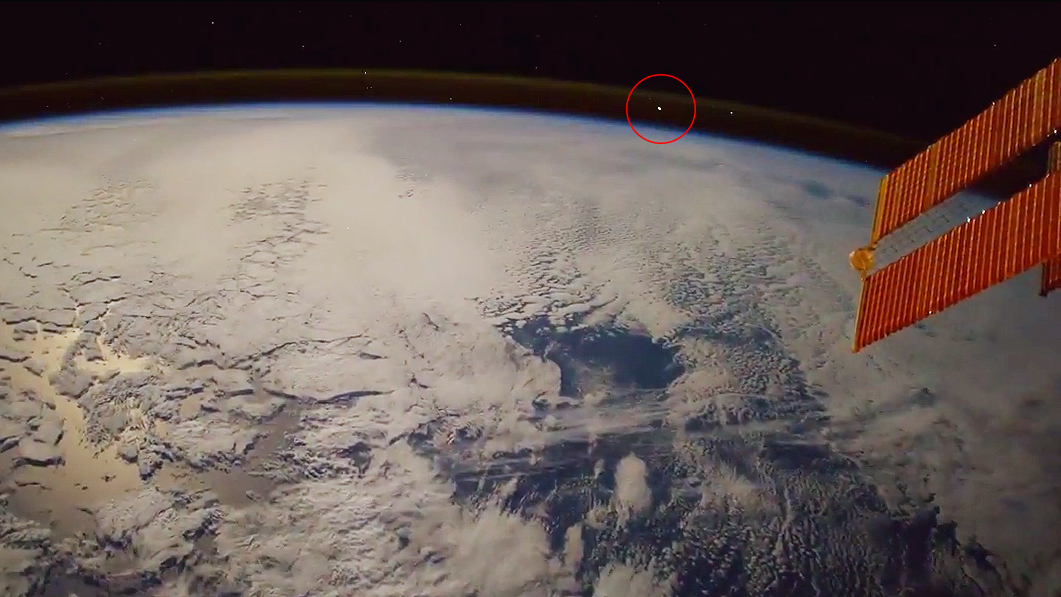Wow! Astronaut Captures Incredible View of 'Fireball' Meteor from Space (Video)
While filming an incredible view of Earth from space, an astronaut aboard the International Space Station (ISS) inadvertently captured a fireball on camera as it whizzed into the atmosphere off the coast of South Africa, above the Atlantic Ocean.
European Space Agency (ESA) astronaut Paolo Nespoli shot the video on Nov. 5 as the ISS flew from a spot over the southern Atlantic Ocean toward Kazakhstan, orbiting about 250 miles (400 kilometers) above Earth. To spot the meteor in the image, look toward the top-right corner of the video.
With three meteor showers raining down on Earth this month, it's tough to say exactly which meteor shower this fireball belongs to. It may have come from the Taurid meteor shower, which peaked a few days later, on Nov. 10. It could also be an early Leonid — that meteor shower peaks this weekend, but it has been active all month long. And the Orionid meteor shower peaked in late October, but it will remain active through the end of November. [5 Amazing Fireballs Caught on Video]

Meteors are pieces of space rock — usually debris from comets or asteroids — that enter Earth's atmosphere at high speeds. Friction with the atmosphere produces heat that vaporizes the meteors, causing them to light up in the sky like "shooting stars." Sometimes, the meteors can splatter when they hit the atmosphere, causing a bright flash of light known as a fireball.
"Indeed it looks like a bright meteor, or fireball," Detlef Koschny, co-manager of the near-Earth object (NEO) segment of ESA's Space Situational Awareness program, said in a statement. "One can see the fireball illuminating the clouds from above, so it must have been close to them — and close to the Earth's limb. It also seems to show a little tail."
Though it certainly looks like a fireball, Koschny said there are other possibilities, such as a re-entering piece of orbiting space debris.
Rüdiger Jehn, another co-manager of ESA's NEO program, calculated that the object seemed to be moving "much faster than typical," entering the atmosphere at 40 kilometers per second, or about 89,500 mph. According to Jehn, that's twice as fast as a typical meteor, "but still in the observable range between 11 and 72 km/s" (approximately 24,600 to 161,000 mph).
Get the Space.com Newsletter
Breaking space news, the latest updates on rocket launches, skywatching events and more!
Also visible in Nespoli's time-lapse video are plenty of clouds and thunderstorms, with blue flashes of lightning scattered across the view. A faint, yellow-orange airglow can be seen above the horizon. This faint emission of light comes from sodium atoms in the so-called sodium layer of the atmosphere, which is located 50 to 65 miles (80 to 105 kilometers) above Earth's surface.
Email Hanneke Weitering at hweitering@space.com or follow her @hannekescience. Follow us @Spacedotcom, Facebook and Google+. Original article on Space.com.
Join our Space Forums to keep talking space on the latest missions, night sky and more! And if you have a news tip, correction or comment, let us know at: community@space.com.

Hanneke Weitering is a multimedia journalist in the Pacific Northwest reporting on the future of aviation at FutureFlight.aero and Aviation International News and was previously the Editor for Spaceflight and Astronomy news here at Space.com. As an editor with over 10 years of experience in science journalism she has previously written for Scholastic Classroom Magazines, MedPage Today and The Joint Institute for Computational Sciences at Oak Ridge National Laboratory. After studying physics at the University of Tennessee in her hometown of Knoxville, she earned her graduate degree in Science, Health and Environmental Reporting (SHERP) from New York University. Hanneke joined the Space.com team in 2016 as a staff writer and producer, covering topics including spaceflight and astronomy. She currently lives in Seattle, home of the Space Needle, with her cat and two snakes. In her spare time, Hanneke enjoys exploring the Rocky Mountains, basking in nature and looking for dark skies to gaze at the cosmos.









